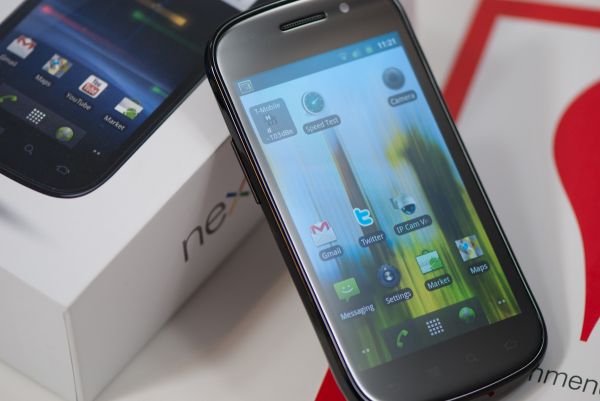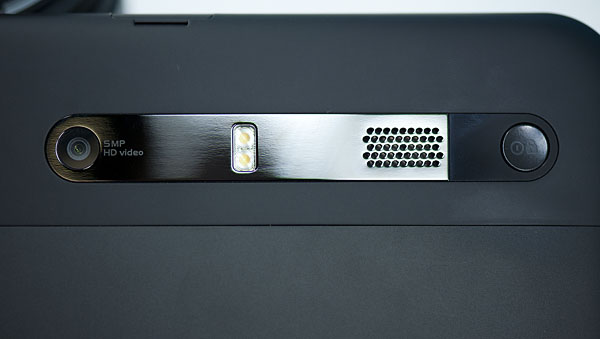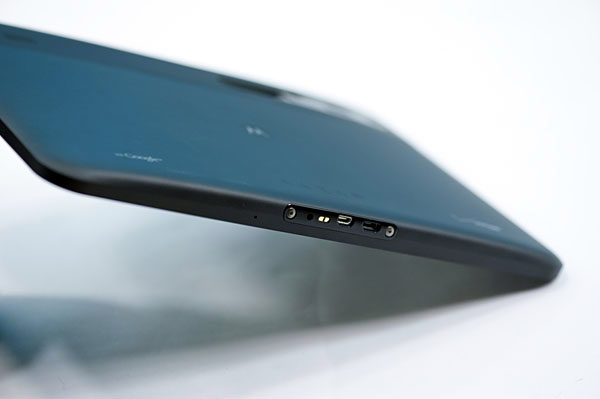Motorola Xoom Review: The First Honeycomb Tablet Arrives
by Anand Lal Shimpi on February 23, 2011 11:57 PM ESTValidation
With the iPad, Apple built a device that I wanted ten years ago, at a time when my workload wouldn’t allow me to use it. I spend most of my days in meetings, producing content, benchmarking and researching. Only the latter is better done on the iPad than a more conventional computing device. The killer apps on the iPad continue to be centered around content consumption and, more recently, gaming. Productivity apps exist, however there are still many usage models that demand the fast response time of a full blown PC or the convenience of a keyboard/mouse, higher resolution display and real working desktop.
That’s just me however. As is evidenced by the number of people I see in airports and airplanes who have traded in their Thinkpads for an iPad, this new era of tablets is serious business. I’m continually amazed by the number of people I see on a regular basis using an iPad, even though I understand why. It’s light, it has a long battery life, it’s easy to use, performance is more predictable than a netbook (thanks to the use of NAND flash vs. a conventional HDD), it’s got a beautiful screen and for some usage models, touching is better than pointing.
A Brief History of Android
Google found itself in an unfortunate predicament in the battle against Apple in the mobile OS space. The iPhone was released in June 2007, but the first Android phone didn’t make it out until October 2008. If Apple were a complacent giant with a stagnant mobile roadmap, showing up 16 months later wouldn’t be an issue. Unfortunately for Google, Apple was anything but that. Execution is critical in any innovation driven industry and Apple has executed extremely well. Since 2007 we’ve seen yearly OS releases (with subreleases in between them) and yearly hardware updates. Since 2007 the hardware updates have come like clockwork, every June we’ve had a new iPhone.
So how do you compete with a company that has a 12 - 24 month head start? Emulation isn’t the answer.
Google would have to out-execute Apple. Similar yearly OS/hardware releases wouldn’t be enough, because Apple would always be ahead at that point. Google wanted to pursue a more open path, with multiple hardware vendors and fully customizable UIs. While that’s great for the consumer, it made Google’s plight that much more difficult.
Apple only had to worry about a single hardware platform that it updated every year. With a dozen or so customers all with varying underlying hardware, Google would have to take longer (or dedicate even more resources) to developing an OS for all of those platforms. Google needed another strategy.
Apple has committed to a 12-month release cadence for OS/hardware, so Google would have to do better than that. On average we get a major Android release every 5 months. Granted Apple does update iOS more frequently than once a year, but Google has definitely come a longer way in the same amount of time thanks to its late start.
A more aggressive release schedule alone isn’t enough. Google wanted to bring Android to more than one hardware manufacturer, but doing so would make out executing Apple nearly impossible. The solution was to pick a hardware and a device partner for each major Android release. Google would work closely with those partners to release the flagship device for that version of Android. All of the other players in the Android ecosystem would be a bit behind the curve. It was a necessary evil in order to rev Android up quickly enough to compete with iOS.

The hardware and device makers were evaluated based on their roadmaps as well as their ability to execute. Last round Samsung was selected as both the SoC and device partner with the Nexus S. Before that it was Qualcomm and HTC with the Nexus One. For Honeycomb, the tablet exclusive release of Android, Google’s SoC partner is newcomer NVIDIA with its Tegra 2. And the device partner? Motorola with the Xoom.
Google and Motorola worked very closely together on the Xoom and as a result, starting tomorrow, the Xoom will be the first Android tablet available running Honeycomb (Android 3.0). Other Honeycomb tablets based on NVIDIA’s Tegra 2 will follow shortly thereafter (Samsung’s Galaxy Tab 10.1, LG’s Optimus Pad) however the Xoom will be first. Down the road we can also expect to see Honeycomb tablets based on other hardware as well.
The Hardware
The Xoom looks and feels like a more rugged iPad. You lose the aluminum finish, but you gain something that feels a lot more grippy and utilitarian. The back is made of the same soft plastic with an almost velvet feel to it that we’ve seen on many smartphones in the past.
The front is all glass of course, however the screen has a much narrower bezel than the iPad making it look a lot more modern. The aspect ratio is also more widescreen than the iPad. The 10.1” screen has a 1280 x 800 display (16:10) vs. the iPad’s 1024 x 768 panel (4:3). As a result the Xoom is the same width in landscape as the iPad, but it’s noticeably shorter (and a little thinner). This gives the Xoom a slightly more manageable feel, although it’s still not as borderline pocketable as a 7-inch tablet.

Motorola Xoom (left) vs. Apple iPad (right)
There are only three physical buttons on the Xoom: volume up, volume down and power/lock. The volume buttons are located along the left edge of the Xoom when held in portrait mode. The power/lock button is actually located on the back of the tablet, near the camera. When held in a landscape orientation the power/lock button should be near the index finger on your left hand. It’s location is actually not that bothersome when you’re holding the Xoom in landscape, it’s when you don’t know how you’re holding the tablet that you run into problems.
The lack of any physical buttons on the face of the Xoom give it a very clean look but also make it very difficult to tell what direction is up when you’re quickly grabbing the tablet. There’s an integrated accelerometer that allows the OS to know how to orient the screen, however when you first pick up the Xoom with the screen off you need to blindly feel around the back for the power/lock button rather than knowing exactly where it is.
Compared to the iPad the accelerometer/rotation magic seems to take longer on the Xoom. The lag between rotating the Xoom and the OS rotating the desktop seems to be just slightly greater on the Xoom compared to the first generation iPad. It’s not a deal breaker, but just a bit odd. Because of the widescreen aspect ratio I found myself using the Xoom in a landscape orientation more than portrait.
There are two cameras on the Xoom: a front facing 2MP and a rear facing 5MP camera with LED flash. The latter is capable of recording up video at up to 720p30. The front facing camera has a red LED next to it that illuminates when the camera is active. Rounding out the light fx are a green charge LED and a white notification LED strip on the front of the Xoom.
There are two speakers on the back of the Xoom, a 1/8” headset jack up top and a micro USB, micro HDMI and power input along the bottom. The micro HDMI port can't be used for mirroring, it looks to be exclusively for getting video out through some of the docks Motorola plans on selling. Update: HDMI mirroring is supported. I couldn't get it working on my Onkyo 508/Samsung UN55C7000 setup however I'll be tinkering around to see why the setup isn't working.
Internally the Xoom has a dual-core NVIDIA Tegra 2 SoC (T20) running at 1GHz. This is the tablet version of the Tegra 2 so it’s a physically larger package but it should have the same performance characteristics. Motorola also includes an Atrix-like 1GB of memory and 32GB of MLC NAND on board. There’s an external facing LTE SIM card tray that also hides the microSD slot in the Xoom.
The Xoom is launching with only one SKU at first: a 32GB 3G (LTE-ready) version priced at $799 through Verizon. This is an unsubsidized cost and it requires a single month of the $20/1GB data plan to function even over WiFi (thank you VZW). The closest Apple competitor is the 32GB iPad 3G priced at $729, a difference of $70. Granted the Xoom does give you two more cameras and two much faster CPU cores than what you get in the iPad, however I’m guessing the more fair comparison will be to the upcoming iPad 2.
| Tablet Specification Comparison | ||||
| Apple iPad | Motorola Xoom | |||
| OS | Apple iOS 4.2.1 | Google Android 3.0 (Honeycomb) | ||
| Dimensions | 242.8mm x 189.7mm x 13.4mm | 249.1mm x 167.8mm x 12.9mm | ||
| Display | 9.7-inch 1024 x 768 | 10.1-inch 1280 x 800 | ||
| Weight |
730g 680g (WiFi only) |
730g | ||
| Processor | 1GHz Apple A4 (Cortex A8) | 1GHz NVIDIA Tegra 2 (2 x Cortex A9) | ||
| Memory | 256MB | 1GB | ||
| Storage | 16GB up to 64GB | 32GB + microSD card | ||
If you want a lower up front cost you can opt for a $599 subsidized version, however that requires a 2-year service agreement at $20. If you’re going to pay for the data plan anyway this may be a better option.
What’s missing of course is a plain old WiFi only Xoom. Motorola says this is coming and will be priced at around $600.














112 Comments
View All Comments
Mumrik - Thursday, February 24, 2011 - link
I'm still waiting for the whole tablet market to implode when users realize that the products makes absolutely no sense at all for 90+% of users and that they're damn expensive for what you get.tomas986 - Thursday, February 24, 2011 - link
I see quite a few people with this opinion. I'm curious to understand why they think that way...The way I figured it, there are two types of digital experience with computers/laptops/tablets/smartphones. I think they call it "media content consumption" and (I assume) "content creation". Content creation is when you have to input data (ie... writing a paper, report, writing emails, creating pics, videos, ...). Content consumption is just reading and viewing the media content.
So, you have to ask yourself, for your computer/laptop/tablet/smartphone usage, how much time do you consume content and how much time do you create content. To understand the potential for tablets, I think you really have to break it down into the two categories.
At work, I do a lot of contest creation, but at home, about 90% of the time, i am just consuming content (read email, surf web, play game,...). Also, on the road/trip/vacation, it is mostly content consumption too.
Tablets are great for content consumption and light content creation (emails, ...), which I believe most people do about 90% of the time away from work (and some people 90% at work too :) ).
So, the tablet is design to satisfy 90% of your computer-related needs away from work. Not to mention, for content consumption, it is a better user experience than computer/laptop (due to touch screen nature).
BTW, I play computer games, so definitely still need a computer. But for me, having a computer and a tablet is much better than a computer and a laptop. Note, the computer is always there, and the tablet can't replace that (for now).
Again, I think you really have to break down your digital/computer experience between consumption and creation. Then it makes more sense for tablet usage.
Impulses - Friday, February 25, 2011 - link
That's just you though... Like me you'd never give up your desktop, but the vast majority of consumers today just have one laptop, and that's it. For most a phone is basically a necessity, and smartphones have exploded because of heavy subsidies and increased functionality, but a lot of people don't need one either.Regardless, when it comes down to spending $800 on a tablet or a new laptop, they're gonna go w/the laptop (possibly a cheaper one at that)... So the tablet remains a luxury item that can't fully replace their main system, nor their secondary device (phone). If these tablets were priced way lower they'd make a lot more sense as a supplementary device, and I'm sure we'll get there eventually...
Right now most people are better served w/something like a Brazos-based ultra-portable tho. Having a tablet on top of that is great for couch use or traveling if you opt for a large laptop, but it's just a luxury item. They've tried to make newspapers and magazines the killer tablet app and I don't think it's catching on much. People that read a lot still prefer an e-reader (or an actual computer if they need to do research/etc.).
strikeback03 - Thursday, February 24, 2011 - link
Anand drives a Camry? I would have expected something more like a BMW or Audi.As far as the screen contrast goes, I find it funny that 750:1 is considered a downside here, while the notebook editors celebrate anytime they find a screen that even hits 500:1.
shadowofthesun - Thursday, February 24, 2011 - link
"I’d love to see a quick search field here so you could just start typing to find the app you’re looking for but perhaps we’ll see that in a future version of the OS."On my Android 2.1 device, typing while in the applications drawer brings up a quick search box which does indeed search apps on the phone.
I vaguely remember my previous motoblur 1.6 device actually filtering the apps if I typed on the physical keyboard, but I can't confirm that ATM.
strikeback03 - Friday, February 25, 2011 - link
plus didn't the page for the google search box show it bring up the app Angry Birds as the first result?ltcommanderdata - Thursday, February 24, 2011 - link
http://www.flickr.com/photos/26574892@N07/54752576...Interestingly, Motorola designed the Xoom's primary product page around Flash, probably to exclude the iPad, but it ironically means the Xoom can't view it yet either.
mrdeez - Friday, February 25, 2011 - link
I will definitely get one of these wifi only when released.....Great fair review. What this unit has going for it IMO,and other android device makers should pay attention to is Battery life. I love my evo but i get anywhere from 5-8 hours on it depending on what i'm doing. I really think ability to actually use these devices without having to charge the battery all the time is a big advantage. Most of the hardware/software quirks will be fixed soon as this is googles developer tablet.chomlee - Friday, February 25, 2011 - link
This is my take away from all of this, and keep in mind, I am not an apple fanboy. My favorite phone is the EVO.My most important factors in a tablet
Best screen - Apple
Best Load time - Xoom
Best UI - Xoom (considering deficencies will be fixed with future android releases)
Battery Life - Tie
Pricing - Apple
Overall, to me it is a tie right now but that is with the current IPad. The next IPad will probably catch up to the the Xoom on most of the benefits and the only benefit of the Xoom may be Honeycomb.
Another factor not mentioned that is really important to me is how you can turn on your 3G service a month at a time and use it on vacations when you need to. I would never get a contract on a tablet device because it would mostly be used at home on the wifi (I think most people are in the same boat). That option is a deal breaker for me.
I would love to have an android device but I have a feeling that the Ipad 2 is going to be even better at a lower price than the xoom, I may end up being one of those drones buying the new IPad.
bplewis24 - Tuesday, March 1, 2011 - link
You forget that there will only be one new iPad releasing this year (most likely), but there will be several Honeycomb tablets emerging on the market. Some will have better screens (Asus Transformer?), some will have better pricing (Galaxy Tab 10.1?), and yet others will have better feature sets ...all while still having the same best-in-class Honeycomb UI.So, while the iPad2 may possibly catch up or even surpass the Xoom on some level, that will be it for the rest of the year, while other Honeycomb tablets will still be shooting for the crown, driving Honeycomb tablet pricing down in the process.
Brandon